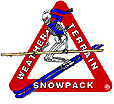Online Climbers Avalanche Course
Module 4 Description - Weather
Select Feedback (from the Level 1 version)
- The average student rating for this module, out of 10, is: 9
- The average student rating for this module in relation to others, out of 10, is: 9
- The percentage of students who felt all objectives were met is: 100%
- Select Student Comments:
- The incident case study of Mt. Hood was a good way of explaining energy balance.
- Overall I think I got the material, and a lot of it was very good.
- The graphics we very helpful.
- The Mt Hood incident was interesting since it is in my backyard.
Overview
This is Module 4 of the online Climbers Avalanche Course
developed and supported by AlpenPro
and offered here in the Avalanche Institute sponsored by the Avalanche-Center.org
. It covers all of the weather material for this course.
The only prerequisite for this module is Module 1 - Introductory Material. This module is a prerequisite the final one on planning a safe climb.
The module covers key observables, wind, energy balance, precipitation, and locating and interpreting suitable forecast products. The emphasis is almost entirely on applied topics, for more in-depth background theory that provides insight and understanding and builds a stronger basis for further studies one should complete the Level 1 version.
Objectives
- List key weather observables and explain their importance in spring
- Understand the spring transition from winter to late spring and summer
- Anticipate potential cornice problems on climbing routes
- Explain and interpret the key elements of energy exchange at the snow surface
- Appreciate the combination of new snow and radiational energy in spring
- Locate and interpret general (non-specialized) weather forecast products
- Interpret the contents of a mountain weather forecast in the context of spring
Topics
This module covers these general topics:
- The Three Key Observable Categories
- The nature of spring as a bridge from winter to summer
- Winds, Energy Balance, Precipitation
- Forecast Products and Interpretation
- Case Studies
- Learning More, References
The Outline on this page shows more detail.
Outline
Welcome, Instructions
Introduction
Key Observables
Seasonal Progression of Weather
Energy Balance
- Mechanisms of Heat Transfer
- Energy Balance at the Snow Surface
- The Spring Energy Balance
Precipitation
- Spring Precipitation
- New Snow in Spring
- Spring Convection
Effects of Wind
Forecast Products and Interpretation
- Weather Forecasts
- NWS Forecasts (US)
Wrap-Up
- Case Study
- Conclusion
- Learning More
- References
- Evaluation
Human and technical Resources
This module has complete access to human resources and technical support. There are numerous ways to contact an instructor and to interact with other students. The module has its own forum for questions and discussion, there is a dropbox for sending documents (including messages) to other students in the module and/or an instructor, there is a messaging system accessed from the top of the web interface, and there is always email.
Assessment
There are quizzes incorporated into this course which allow students to check their understanding of the material. Quizzes may be taken as many times as desired, either to obtain a passing score or just to attempt to ultimately get a perfect score.
All quizzes in this module are taken and scored online, nothing is submitted for human review.
Successful completion of this module requires passing all assessments.
Course material
The materials used in this module were developed by AlpenPro. They evolved through the development of a climbers course taught in a traditional format each spring starting in the 1990s.
There is a pdf workbook which is a short supplement to the online material. It can be printed throughout the module and used for taking notes, and/or it can be printed as one file at the end of the module.
A few items are from the Avalanche Center website. Links are provided to external resources where appropriate.

 Avalanche Institute Home
Avalanche Institute Home